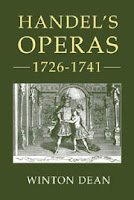
To commemorate the 250th anniversary of Handel’s death, BBC Radio 3 is broadcasting a complete cycle of the composer’s operas. These can be heard every Thursday at 2pm (UK time) as well as over the internet for a week after each broadcast. It is easy to take such a wealth of material for granted in these anniversary years, but as Winton Dean points out in one of the epilogues to his acclaimed Handel’s Operas 1726-1741, it is only relatively recently that these works have been performed at all:
The revival of Handel’s operas in the modern theatre, after not one of them had been performed anywhere between 1754, when Handel was still living, and 1920, has been among the most remarkable phenomena in the history of the art. But it is not a straightforward story, and not all its implications are fully understood. There were hurdles, both musical and dramatic, to be surmounted. The art had moved from opera seria to Gesamtkunstwerk, leaving a huge gap to be bridged by public taste. Looking back, one must conclude that the movement got off on the wrong foot, and has not always retained its balance since.
In 1920 a shaky start was inevitable. When in that year Oskar Hagen and his colleagues at Göttingen set the ball rolling with their production of Rodelinda, followed soon after by Ottone, Giulio Cesare and Serse, their achievement could be likened to Samuel Johnson’s comparison of a woman preaching to a dog walking on his hind legs: it was not done well, but you are surprised to find it done at all. An idiom based on the solo singer, the da capo aria, secco recitatives, castrato heroes and an almost total absence of ensembles was the absolute antithesis of the current fashion for huge orchestras, rich post-romantic harmony and plots heavy with symbolism as exemplified by Wagner’s successors and the operas of Strauss, Pfitzner and Schreker.
It is hardly surprising that Hagen virtually rewrote Handel’s operas, rescoring them (recitatives included) for a massive orchestra, making devastating cuts, chopping up every aria by shortening ritornellos and abolishing da capos, rewriting stage directions wholesale, dragging in music from elsewhere, and transposing all high male parts down an octave, seemingly from a distaste for the unnatural and unmanly voice of the castrato. These versions were immensely popular in Germany and produced in dozens of cities over the next few years. a pattern was set, and arrangements of further operas by different companies soon followed. By the outbreak of the second World War nineteen of Handel’s operas had been revived in German theatres, nine of them at Göttingen. The more extreme distortions were dropped fairly soon, but Hagen’s arrangements (modified) could still be heard in Munich and elsewhere in the 1960s. The annual Handel Festival at Halle, founded in 1952, continued for some years to perform the operas with inflated scoring, slow ponderously accented recitatives, long pauses for scene changes during acts and automatic octave transposition. The results can be studied in a 1959 Halle recording of Poro, heavy with superimposed brass, which even renamed some of the characters, or in ten German recordings of Giulio Cesare up to 1970, where an opera composed for six high voices with two small bass parts is torpedoed and sunk by five basses and a tenor.
Germany did at least show interest in the operas, leaving the English-speaking countries far behind. There Handel remained fixed like Jehovah in his everlasting seat, revered as a great choral and religious composer, a pillar of the state and the Anglican Church, erected in the eighteenth century and reinforced ever since by the frequent repetition of three or four oratorios. Up to 1955, by which time Germany had seen twenty-five of the operas on the stage, precisely four had been presented in Britain, each in a single production by an amateur or ad hoc company, and three of the same four likewise in the United states – all between the wars and not one in a regular opera house. In Britain the oratorios, appreciated sooner for their dramatic qualities, had received far more stage performances than the operas.
The climate began to change with the foundation in 1955 of the Handel Opera Society in London, with Charles Farncombe as conductor, followed four years later by two further enterprises, the brave attempt by Frances and Alan Kitching at Abingdon to recreate the flavour of a Baroque performance, albeit on a diminutive scale, and the first of a series of productions at the Barber Institute of Birmingham University, conducted by Anthony Lewis and Ivor Keys. none of these offered much in the way of spectacle. The staging was elementary, though there was some first-rate singing, especially at Birmingham; their significance lay in their demonstration (despite occasional backsliding) of the crucial importance of restoring heroic male parts to the correct pitch.
About the same time a reaction against the ponderous blowzy treatment of the orchestra traditionally inflicted on Baroque music (that of Bach in particular) was giving place to a more historically orientated style based on smaller orchestras, lighter textures, springier rhythms and in due course idiomatic ornamentation, vocal and instrumental, led by practical scholars such as Thurston Dart, Arnold Goldsbrough’s English Chamber orchestra and Neville Marriner’s Academy of St Martin-in-the-Fields (founded in 1959). among other things this allowed the countless felicities of Handel’s orchestration to shine through the murk. a few years later Christopher Hogwood went one step further, substituting period instruments (or facsimiles) for their modern equivalents. The movement was soon international, but its effect on Handel’s operas was unevenly distributed.
Handel’s Operas 1726-1741 is available from all good booksellers. Further extracts will appear on this blog throughout the year.

No comments:
Post a Comment